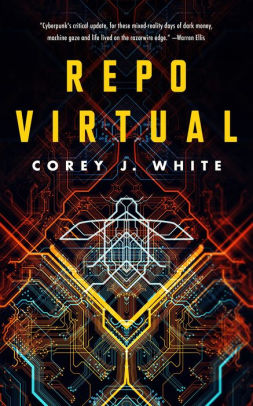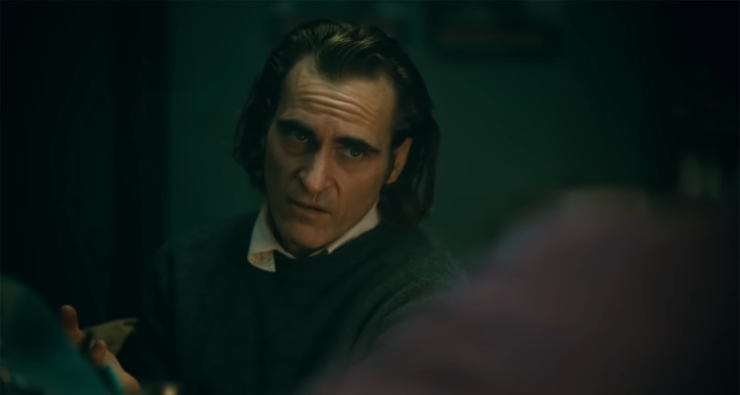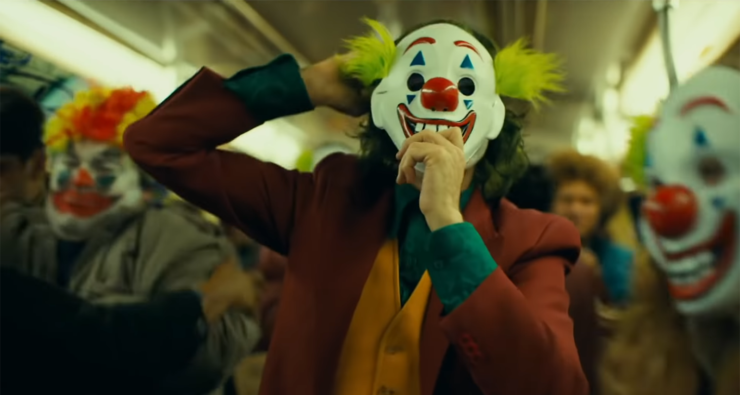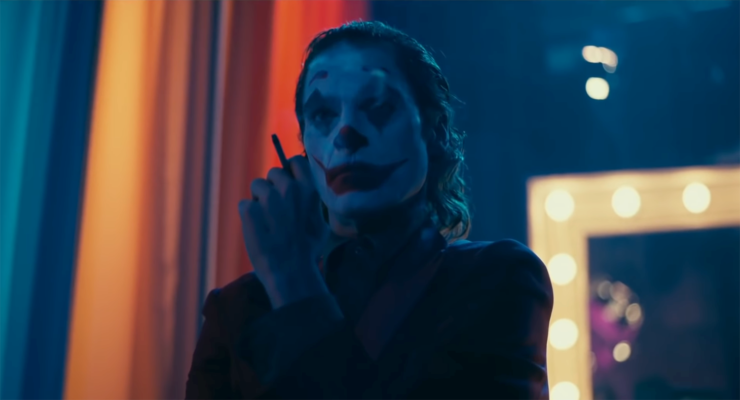Batman’s debut in Detective Comics #27 in 1939 was a massive hit, so much so that National Periodical Publications gave him his own title in 1940, though he also continued to star in Detective Comics.
Batman’s villain in the debut issue of his eponymous comic was the Joker. The story of the character’s creation is a he said/he said mess among Bob Kane, Bill Finger, and Jerry Robinson, but they all at least agree that the Joker’s look was inspired by Conrad Veidt in the 1928 movie adaptation of Victor Hugo’s The Man Who Laughs and a joker playing card.
He quickly became Batman’s arch-villain, and has remained so for eighty years.
Joker has had numerous origin stories over the years, but they don’t always match, and they’re always left particularly vague. Very few of those origins have revealed his real name. The general origin has remained mostly consistent in that the Joker was a criminal (often a costumed criminal called the Red Hood) who fell into a vat of chemicals that bleached his skin and turned his hair green.
Only twice has he been given a full name, both in live-action movie adaptations: Jack Napier, as played by Jack Nicholson in 1989’s Batman, and Arthur Fleck in 2019’s Joker.
Buy the Book


Repo Virtual
Todd Phillips had been fascinated by the Joker character, and was interested in doing a comic book movie that was more grounded in reality. Because Joker’s origin was vague and contradictory, Phillips felt that there was more creative freedom to explore the character without being too bound to the comics. To that end, the first thing he got rid of was dipped-in-acid origin, deemed too outrageous. Phillips wanted his film to be completely grounded in reality.
Joaquin Phoenix had long been fascinated by the idea of doing a character study of a super-villain, but didn’t want to commit to a series of films, as taking a role in, say, the Marvel Cinematic Universe would require. Initially not interested in the Joker because he had been done so many times (Cesar Romero in the 1966 TV show, Nicholson, Heath Ledger in The Dark Knight, Jared Leto in Suicide Squad, not to mention Mark Hamill’s incomparable voice work in numerous animated series), Phoenix was put together with Phillips and a beautiful friendship was born.
Phillips and cowriter Scott Silver set the story in 1981 and included Thomas Wayne, father of Bruce, as an antagonistic supporting character. Inspired partly by the origin provided by Alan Moore and Brian Bolland in the 1988 graphic novel The Killing Joke (specifically that the future Joker tried to pursue a career in standup comedy to pay the bills and wasn’t very good at it), but mostly by the Martin Scorcese movies The King of Comedy and Taxi Driver (going so far as to cast Scorcese regular Robert De Niro in a supporting role), the movie showed the evolution of Arthur Fleck into the psychotic killer we know from the comics.
Supporting Phoenix as Fleck are De Niro as Murray Franklin, a late-night TV talk show host who is a combination of Joe Franklin and Jay Leno, Brett Cullen as Thomas Wayne, Zazie Beetz (last seen in this rewatch in Deadpool 2) as Fleck’s neighbor, Frances Conroy as Fleck’s mother Penny, Douglas Hodge as Alfred Pennyworth, Dante Periera-Olson as eight-year-old Bruce Wayne, and in various other roles, Shea Whigham, Bill Camp, Glenn Fleshler, Leigh Gill, and Josh Pais.
The movie was released to general acclaim from critics and mixed reviews from comics fans. Phoenix has already received a Best Actor Golden Globe, and the movie received an impressive eleven nominations each from both the Academy of Motion Picture Arts & Science and the British Academy Film Awards.
“All I have are negative thoughts!”
Joker
Written by Todd Phillips & Scott Silver
Directed by Todd Phillips
Produced by Todd Phillips, Bradley Cooper, and Emma Tillinger Koskoff
Original release date: October 4, 2019

Arthur Fleck is a clown-for-hire in 1981 Gotham City, which is gripped by a garbage strike. He’s having mandatory counseling sessions, following being hospitalized for mental illness. He’s also on several meds, and has pseudobulbar affect, a condition that causes him to involuntarily laugh out loud whether its appropriate or not. (He has a card he can show people when this happens around strangers, which he has to give to a woman on a bus at one point.)
While working outside a music store that’s going out of business, some kids steal Fleck’s “GOING OUT OF BUSINESS SIGN.” They lead him on a chase through the streets and into an alley where they whack him in the face with the sign (which shatters it) and then kick the shit out of him.
Fleck returns home, where he lives in a tiny apartment in an old, poorly kept building with his mother. His mother, Penny, has been writing letters to Thomas Wayne, for whom she used to work. Wayne is considering running for mayor, and Penny is hoping that Wayne will help them once he learns what squalor they’re living in.
Fleck also has a brief encounter with his neighbor Sophie, a single mother. They have a weird, awkward conversation in the elevator.
Each night, Fleck and Penny watch The Murray Franklin Show, a late-night talk show. Fleck hallucinates being in the audience for the show and being singled out by Franklin, who then calls him up onto the stage and tells him what a good guy he is.
The next day, Fleck follows Sophie to work and around the city.
Randall, one of Fleck’s fellow clowns, commiserates with him over what happened at the music store and then gives him a gun to protect himself. Fleck doesn’t like the idea, but takes it.
The boss calls him into his office reprimanding him for walking off the job and stealing the store’s sign. Fleck explains what happened, but the boss doesn’t believe it.
He does a gig at a children’s hospital, and the gun falls out of his pocket during his routine. He tries to pass it off as a prop gun that’s part of the act, but nobody believes that, and he’s fired, especially since Randall claims that Fleck tried to buy a gun off him.
On the train home, three dudebros in suits are harassing a woman. Fleck starts laughing uncontrollably, and the dudebros turn their attention to him, one of them singing “Send in the Clowns,” since Fleck is still in his clown makeup. They start harassing him aggressively, throwing his bag around and kicking the shit out of him the same way the kids did, but then he shoots two of them and chases down the third and shoots him on the 9th Street platform.
Despite there being no witnesses (except the woman, so maybe it came from her?), the fact that a guy who looked like a clown shot three young men (who all worked for Wayne Enterprises) becomes a major news story. In particular, people are taking the clown’s side for taking a stand against the rich bastards. Wayne himself goes on TV and refers to the people siding with the killer as clowns, a remarkably tone-deaf statement by someone who’s planning to run for mayor.
Wayne’s comments just make things worse, as people start dressing as clowns and protesting. Meanwhile, we see Fleck going on dates with Sophie, honing his standup act, and actually getting a gig at a club called Pogo’s, after going around to other clubs and taking notes about people’s acts. He opens his act with a very long nervous laugh, though when he gets past that, his jokes get a laugh or two, at least, and we see Sophie in the audience cheering him on.
Unfortunately, city services are being cut, and Fleck will no longer be able to get his counseling sessions, nor receive his meds.
Penny writes another letter to Wayne, and this time Fleck decides to open it and read it. To his shock, in it Penny claims that she and Wayne had an affair, and Fleck was the result of their liaison. Fleck is furious, but eventually calms down.
He then takes a commuter rail to the suburbs and approaches Wayne Manor (which is quite stately), and tries bonding with Wayne’s eight-year-old boy Bruce with magic tricks. Then the Wayne’s butler, Alfred, intercedes. When Fleck says who he is, Alfred explains that Penny is delusional and there was no affair with Wayne. Fleck starts to strangle Alfred through the gate, but stops at Bruce’s look of horror. Then he leaves.
When he arrives home, there’s an ambulance at the building and Penny is being taken away—she’s had a stroke. Fleck accompanies the ambulance to the hospital. He sits with her, and we see Sophie by his side.
At one point, he steps outside for a cigarette break, and there are two detectives waiting. Turns out they were talking to Penny and their questions about Fleck led to her being agitated, which in turn led to the stroke. Fleck refuses to speak to them.
Fleck watches The Murray Franklin Show in Penny’s hospital room. Franklin got his hands on video footage of Fleck’s show at Pogo’s and he mocks Fleck’s performance rather nastily. Fleck is devastated.
Wayne is attending a gala opening of a movie theatre, and there are protests outside of people in clown masks. Fleck somehow manages to sneak in despite there being a massive police presence, steals an usher outfit and walks around with impunity (nobody ever notices the ushers). He sees Wayne in the men’s room and confronts him. Wayne explains that, not only is Penny delusional and committed to Arkham State Hospital, but also Fleck himself was adopted. Fleck is livid, and denies it, and yells at Wayne, who punches Fleck in the face.
Fleck goes to Arkham and manages to steal his mother’s file, which confirms that she was indeed hospitalized there with delusions and because she endangered her child—or, rather, her adopted child, as copies of the adoption papers are there. According to the file, she sat and watched while her boyfriend abused Fleck, possibly causing him brain damage. (We also get a flashback to one of her interviews, even though Fleck couldn’t have been there.)
Returning to the hospital, Fleck suffocates his mother with a pillow. This somehow goes unnoticed by hospital staff. (Then again, Fleck was smoking in the room prior to killing her, which isn’t allowed, and nobody noticed that, either…)
When he gets home, he goes into Sophie’s apartment (which is inexplicably unlocked; nobody who lives in an apartment in a big city leaves their door unlocked, I don’t care how many times you saw it in Seinfeld), which scares the hell out of her. She says, “You’re Arthur from down the hall, right?” at which point we realize that every encounter we’ve seen with Sophie has been as much a delusion as his “appearance” on Murray Franklin, and that this is the first time he’s seen her since their elevator meeting.
Back in his own apartment, he gets a call from Franklin’s booker. Apparently the footage of his routine was popular, so Franklin now wants him on the show. Stunned, Fleck agrees.
The night of the recording, there are protests planned at City Hall, with tons of people in clown outfits protesting the garbage strike and the state of the city. Fleck starts to put on clown makeup, but midway through, there’s a knock at his door: it’s Randall and another of their fellow clowns, Gary, a little person. Fleck stabs Randall in the eye with a pair of scissors in revenge for helping get him fired. He lets Gary go, though, as Gary was always nice to him.
He cleans the blood off, finishes putting on his clown makeup and suit, and then goes to the studio. On his way, he’s chased by the two detectives, but he loses them in the subway, which is full to bursting with people in clown regalia heading to the protest. In the confusion, one detective’s gun goes off and a riot starts.
Fleck gets away in the confusion and arrives at the studio, where Franklin is a bit surprised by the clown makeup, thinking it’s a political statement, but Fleck insists it’s just part of his new standup act.
Franklin introduces him by his own request as “Joker,” as when he made fun of Fleck on the show previously he introduced the footage of Pogo’s by saying, “Check out this joker.”
Fleck goes on an unfunny screed about any number of subjects, including how people like him and his mother are ignored and tread upon and also taking credit for being the clown killer on the subway. Contrary to his saying his clown makeup wasn’t political, he goes on a very political rant, concluding it with shooting Franklin in the face.
He’s arrested, but the cop car is T-boned by a stolen ambulance driven by someone in a clown mask, who pulls Fleck out of the vehicle.
The Wayne family exits a movie theatre (which is playing Blow Out and Zorro the Gay Blade) and try to get away from the rioting in the streets. The guy who stole the ambulance follows them into the alley and kills both Wayne and his wife Martha while Bruce watches.
Fleck is eventually arrested again and hospitalized. He laughs at the doctor examining him, and when she asks what’s funny, he says she wouldn’t get it. The next shot is him walking alone down the hallway leaving bloody footprints behind, so he presumably killed the doctor. The last scene is him being chased by an orderly.
“There is no punchline”

The responses to this movie were many and varied, ranging from fulsome praise (particularly, though not exclusively, from film critics, not to mention film academies of two different countries) and nasty vitriol (particularly, though not exclusively, from comics fans, not to mention people decrying the violence). I was hoping to come down on one side or the other once I finally saw it, but sadly, I’m just as conflicted as the aggregate opinions.
First of all, let me state up front that this is a brilliantly made movie. Beautifully filmed, excellently acted, cleverly scripted. Todd Phillips chose several fairly run-down locations and also many buildings in the Bronx, Brooklyn, Jersey City, and Newark that haven’t changed much in the last forty years.
The era is generally portrayed well, though—as is far too common—the clothes and hair are completely wrong. But the set design gets it right, at least, as the cars are all accurate, as is the available technology (corded phones, no computers or cell phones, old graffiti-covered subways, etc.), plus there’s lots of indoor smoking going on. (The only time someone goes outside to smoke is at a hospital.)
Joaquin Phoenix’s performance is one of those really strong performances that nonetheless never lets you forget that he’s acting. It’s both impressive and completely not naturalistic. Which is fine, I have no problem with this type of performing, generally, except it’s in a movie that’s going for stark realism, so the mannered acting doesn’t seem to fit, almost like he’s acting in a different movie.
And what’s especially hilarious about his doing so is that Joker should be played in an over-the-top way, in the abstract. He’s an archetypal, larger-than-life, mysterious figure. But this movie isn’t about that, it’s about deconstructing that. He’s not a manic, insane force of nature who will go on to kill Robin and maim Batgirl, he’s a mentally ill aspiring stand-up comic who was raised by a delusional narcissist (with whom he still lives), possibly is suffering brain damage from being beaten as a boy, and then has had his counseling and meds cut off by Ronald Reagan’s social services cuts. (Reagan isn’t mentioned by name, but we can assume.) He doesn’t cackle all the time because he’s batshit crazy, he cackles all the time because he has a medical condition (he has a card to hand people and everything). It helps to ground the character, make him feel more real—but it also lessens him in so many ways.
Joker isn’t a super-villain anymore. It’s hard to say what he is. He’s the protagonist of the film, obviously, but he’s also an asshole. The movie tries to make us understand him better, and show how he’s a victim of the system, but do we really want to feel sorry for this guy who guns down three people in the subway? One of whom he, in fact, chases down in the subway and murders in a manner that is 100% premeditated.
It’s an interesting notion to have Joker be the cinematic/DC universe equivalent of Bernhard Goetz. In 1984, Goetz shot four African-American kids on a New York subway who he thought were trying to rob him. To be clear, the four victims of Goetz’s shooting had criminal records and testified that they were on their way to a robbery. Nonetheless, Goetz took it upon himself to shoot the four, an extreme penalty for asking for five bucks, even if it was a mugging rather than panhandling as the four said at the trial.
It was a cause célèbre here in New York in the 1980s, with opinions on Goetz hugely divided, in terms of extreme response, in terms of the high crime rate in New York in 1984, in terms of it being white-on-black violence, and in terms of vigilantism.
Phillips was very obviously inspired by the Goetz case, though he hedges his bets by making his victims wealthy white guys who are sexually harassing a woman, so you have a much easier time watching them get shot.
And that’s just a cowardly way to approach it. Joker’s supposed to be a villain. That’s the whole point of the character. Why not make his victims a gaggle of poor African-American kids? Instead, they’re “safer” victims, members of the 1% against whom the poor of the city already have an animus. They’re easy targets, and they also are yet another attempt to make Fleck/Joker into a sympathetic victim, which is a problem for a mass murderer.
The guy in the clown makeup who shot the three dudebros becomes a rallying point in Gotham after that, and my first thought watching it was: how? This is 1981—surveillance in subways wasn’t really a thing then. And there was literally nobody else around. The woman the dudebros had been harassing was long gone, and there was nobody else in the car, nobody else in the train station. How do people even know that a guy in clown makeup shot these guys? I mean, I suppose the conductor or engineer saw it, but that’s not at all clear in the movie, which goes out of its way to make the subway and the platform be completely empty.
The thing is, as a critique of the inconsistent and harmful way the modern U.S. tends to treat the mentally ill, this movie is pretty damn good. The system completely failed the Fleck family, mère et fils, and the results are horrible and, up to a point, believable.
Part of the problem is that this is a popular movie, and in popular movies, heroes kill people all the time. It’s part of the price of doing business if you’re in an action movie. Joker keeps killing people who’ve hurt him, and a lot of them aren’t nice people, from the dudebros on the subway to his mother who lied to him to his fellow clown who helped get him fired to Murray Franklin who mocked him on television. He even spares the little person who was nice to him, so how bad can he be?
But he is bad. Yes, the system failed him, but it fails lots of people with mental illness who don’t go on killing sprees. Fleck at once is too broken and not broken enough for this to entirely work.
And yet, just the fact that there’s so much here to unpack and talk about shows that it’s a well-made piece of art. I think Phillips would’ve been better off divorcing it entirely from DC and just doing a piece about Arthur Fleck. We could keep De Niro’s magnificently smarmy talk show host and the backstory with an industrialist who has a different name than Thomas Wayne. (As it is, this movie continues the 2010s tradition of DC heroes’ fathers being assholes, following the character assassination of Jonathan Kent in Man of Steel. Seriously, Thomas Wayne is a total tool in this movie, with a level of tone-deafness that indicates that his run for mayor would not have survived primary season, had he lived that long.) As it stands, this feels like bad Joker fanfic rather than a strong movie about what makes a serial killer.
Also, I really didn’t need to see the Waynes get shot while young Bruce looks on again. Especially since Phillips can’t resist again showing Martha Wayne’s pearl necklace shattering, riffing on that Frank Miller visual from The Dark Knight Returns yet again. (Which makes no sense anyhow, as pearl necklaces worn by very rich people do not break that easily.)
This brings “4-Color to 35-Millimeter” to a pause, as we’ve now caught up to real time. There are literally no more live-action feature-length movies based on superhero comics to write about—
—yet. The 2020 docket currently includes Birds of Prey (And the Fantabulous Emancipation of One Harley Quinn), Black Widow, Bloodshot, Eternals, Morbius, The New Mutants, Venom 2, and Wonder Woman 1984. The plan is to put this feature on hold until December, when I’ll take a look back at the year’s superhero releases. Edited to add: I forgot to include The King’s Man in the list! And apparently, there was a movie based on Faust from 2000 that I totally didn’t know about…
In the meantime, thank you all for reading this overview of the hottest thing in cinema in the early 21st century, going all the way back to its roots in the 20th. This has been a delightful look back at a subgenre through its extremely high ups (The Dark Knight, Black Panther) and very low downs (Son of the Mask, Man-Thing), and I got to learn a few things too (like I had no idea there were Dick Tracy films in the 1940s!).
I’m not going anywhere on this site, of course. As announced yesterday, next Thursday will see the debut of the Star Trek: Voyager Rewatch, and I’ll also be reviewing each episode of Star Trek: Picard’s first season and Star Trek: Discovery’s third season as they’re released. And I’ll keep babbling about other TV shows, movies, and more ’round these parts, worry not.
Thank you all again. Most of these entries had thirty-plus comments, and more than a score broke into three figures. Best of all, though, unlike far too many internet comments sections, this one was free of trollery and melodrama, and instead was intelligent, fun discourse about the movies in question. You all have my eternal gratitude, appreciation, and admiration for that.
Excelsior!
Keith R.A. DeCandido is looking forward to every single 2020 superhero movie release, with the possible exception of Bloodshot (about whom he has no feelings one way or the other) and Venom 2 (because the first one was, um, not good). He is particularly heartened to see that four of the eight movies have female leads. About damn time.










